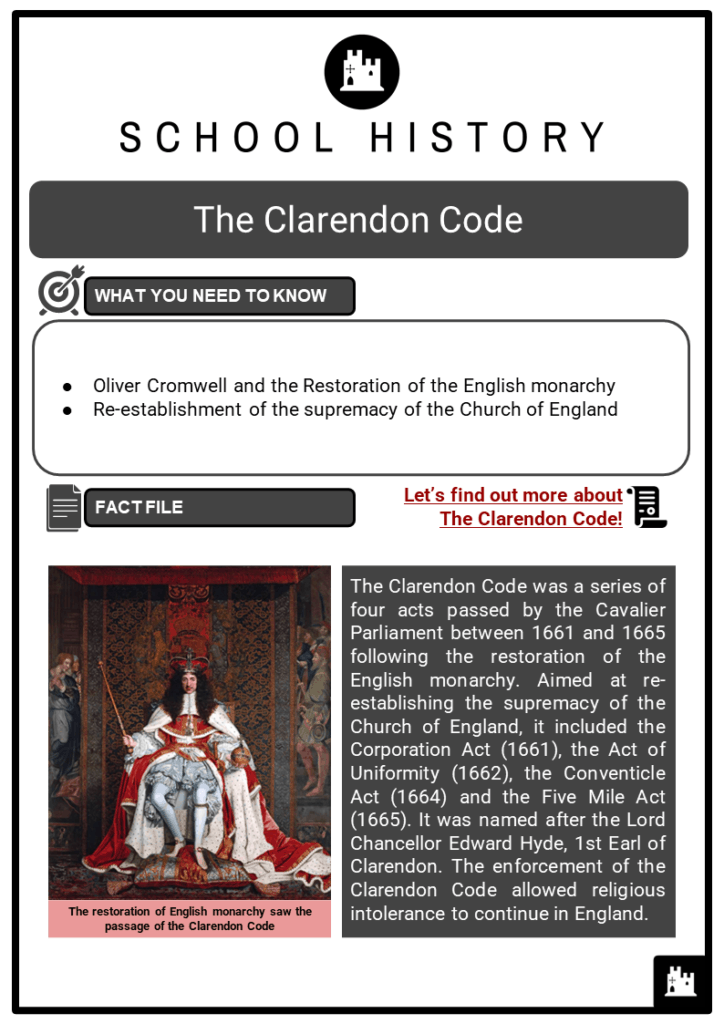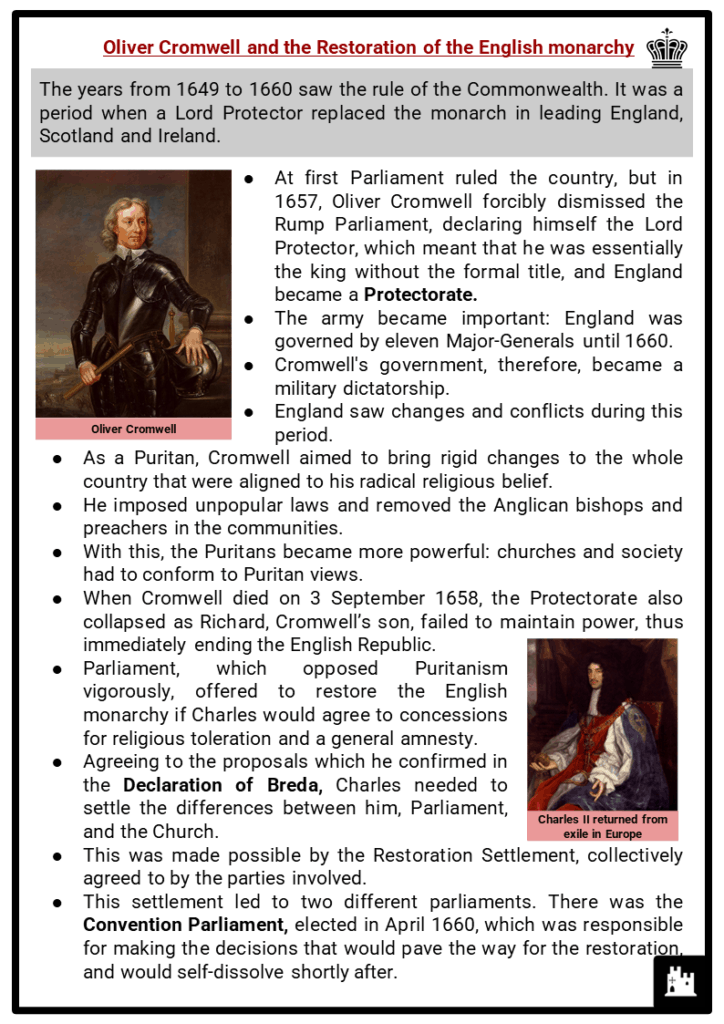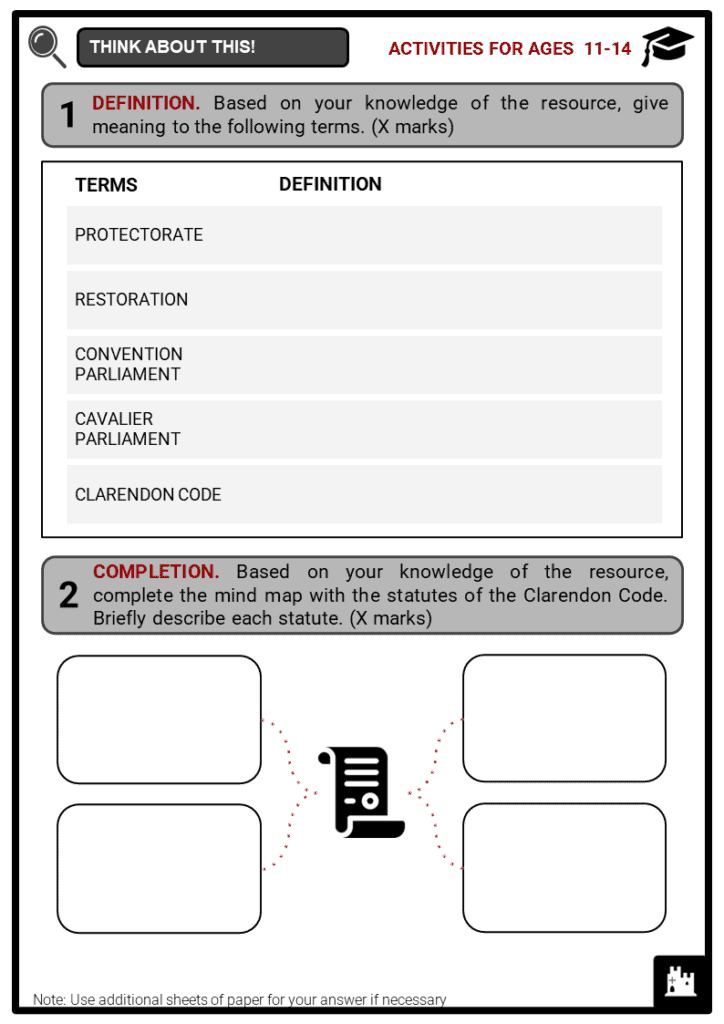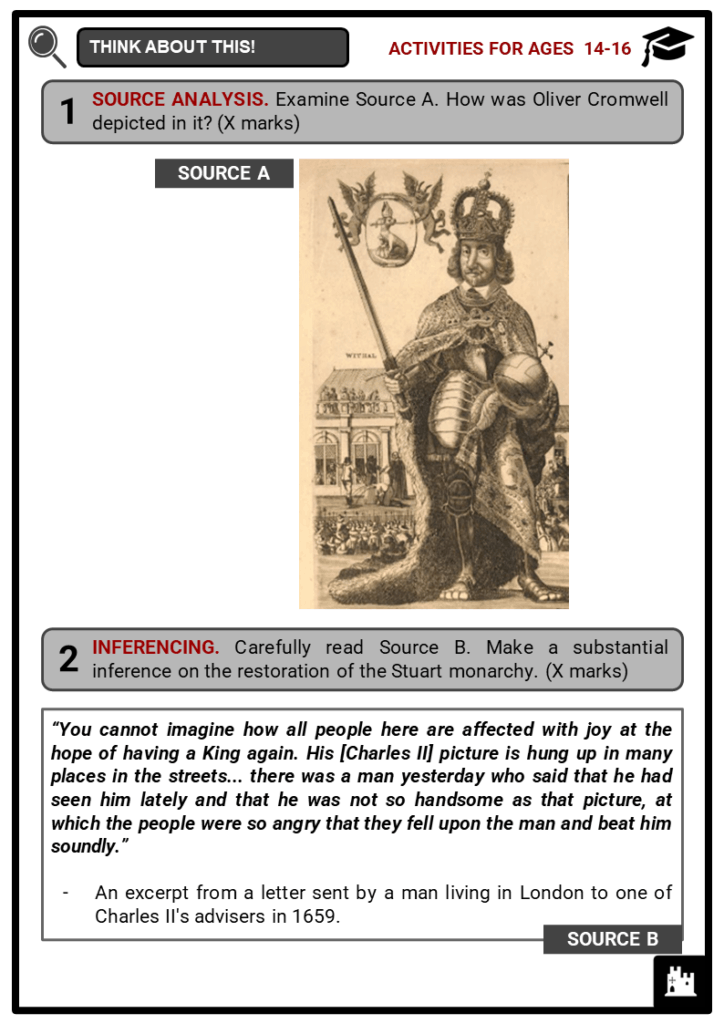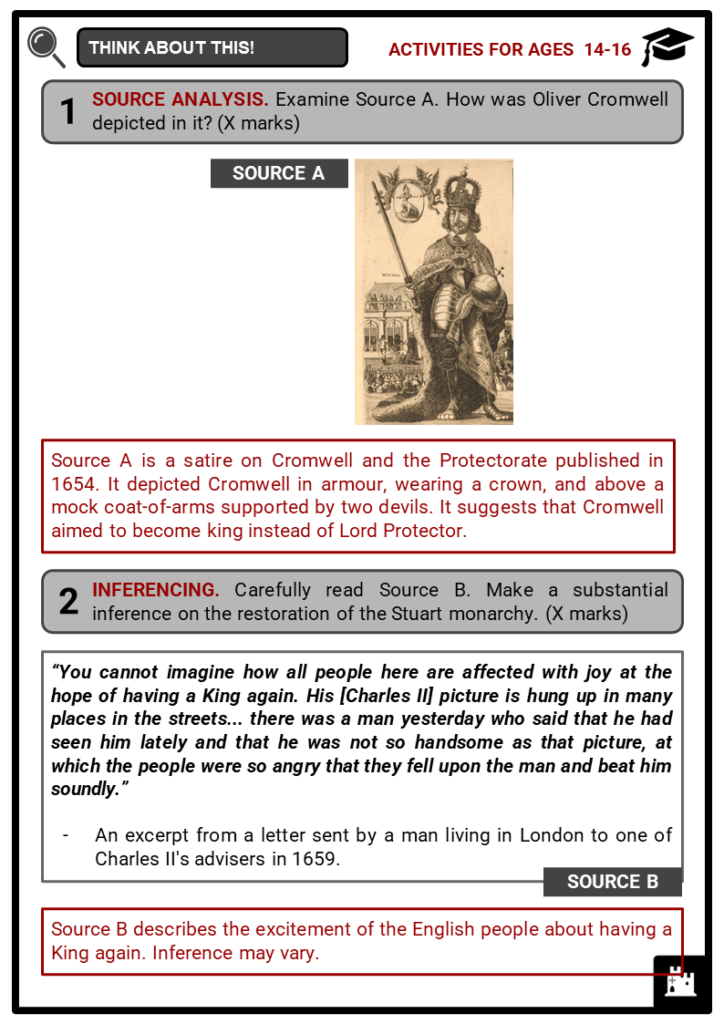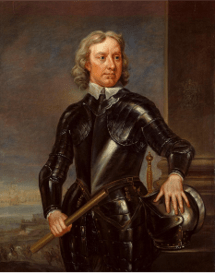Download The Clarendon Code Worksheets
Do you want to save dozens of hours in time? Get your evenings and weekends back? Be able to teach The Clarendon Code to your students?
Our worksheet bundle includes a fact file and printable worksheets and student activities. Perfect for both the classroom and homeschooling!
Table of Contents
Add a header to begin generating the table of contents
Summary
- Oliver Cromwell and the Restoration of the English monarchy
- Re-establishment of the supremacy of the Church of England
Key Facts And Information
Let’s find out more about The Clarendon Code!
- The Clarendon Code was a series of four acts passed by the Cavalier Parliament between 1661 and 1665 following the restoration of the English monarchy. Aimed at re-establishing the supremacy of the Church of England, it included the Corporation Act (1661), the Act of Uniformity (1662), the Conventicle Act (1664) and the Five Mile Act (1665). It was named after the Lord Chancellor Edward Hyde, 1st Earl of Clarendon. The enforcement of the Clarendon Code allowed religious intolerance to continue in England.
Oliver Cromwell and the Restoration of the English monarchy
- The years from 1649 to 1660 saw the rule of the Commonwealth. It was a period when a Lord Protector replaced the monarch in leading England, Scotland and Ireland.
- At first Parliament ruled the country, but in 1657, Oliver Cromwell forcibly dismissed the Rump Parliament, declaring himself the Lord Protector, which meant that he was essentially the king without the formal title, and England became a Protectorate.
- The army became important: England was governed by eleven Major-Generals until 1660.
- Cromwell's government, therefore, became a military dictatorship.
- England saw changes and conflicts during this period.
- As a Puritan, Cromwell aimed to bring rigid changes to the whole country that were aligned to his radical religious belief.
- He imposed unpopular laws and removed the Anglican bishops and preachers in the communities.
- With this, the Puritans became more powerful: churches and society had to conform to Puritan views.
- When Cromwell died on 3 September 1658, the Protectorate also collapsed as Richard, Cromwell’s son, failed to maintain power, thus immediately ending the English Republic.
- Parliament, which opposed Puritanism vigorously, offered to restore the English monarchy if Charles would agree to concessions for religious toleration and a general amnesty.
- Agreeing to the proposals which he confirmed in the Declaration of Breda, Charles needed to settle the differences between him, Parliament, and the Church.
- This was made possible by the Restoration Settlement, collectively agreed to by the parties involved.
- This settlement led to two different parliaments. There was the Convention Parliament, elected in April 1660, which was responsible for making the decisions that would pave the way for the restoration, and would self-dissolve shortly after.
- The second, the Cavalier Parliament, was elected in May 1661, and was responsible for the changes during the restoration itself and the increase in the power of the monarch.
- The return of the Stuarts to the Crown marked the strengthening of the Church of England.
Re-establishment of the supremacy of the Church of England
- The Restoration of the English monarchy saw the relaxation of the strict Puritan morality of the previous rule. The Church of England was restored as the national church in England, backed by a group of English statutes known as the Clarendon Code.
- The Clarendon Code was a series of the four acts passed by the Cavalier Parliament between 1661 and 1665 that intended to protect the Church of England from subversive tendencies.
- The Cavalier Parliament was dominated by Anglicans who feared a social revolution by dissenters. The enactment of the code was driven by this fear.
- The Clarendon Code was named after Edward Hyde, 1st Earl of Clarendon, and Lord Chancellor of Charles II after the Restoration Settlement.
- Although the code was named after the chief minister, Clarendon was not heavily involved with its drafting.
- In fact, he disapproved of much of its content as he had been a leading member of the Great Tew Circle, a group of theologians, philosophers and poets who supported tolerance and held respect for religious differences.
- When the code was passed, however, Clarendon worked for their enforcement.
- Aims of the Clarendon Code:
- Strengthen the position of the Church of England
- Restrain the power of the Nonconformists, or Dissenters
- Four statutes of the Clarendon Code:
- Corporation Act (1661) This first of the four statutes required all individuals working within the government to embrace the Anglican Church and formally reject the Solemn League and Covenant. This act intended to exclude all Nonconformists from public offices.
- Act of Uniformity (1662) This second statute made the use of the Book of Common Prayer mandatory in church services. About 1760 ecclesiastics, 150 dons and teachers refused to comply with this act and were forced to resign and lose their living.
- Conventicle Act (1664) This third statute prohibited conventicles, or the unauthorised worshipping meetings, of more than five people who were not members of the same household. The aim was to prevent dissenting religious groups from coming together.
- Five Mile Act (1665) This final statute intended to forbid Nonconformist ministers from living within five miles of the parishes from which they had been expelled, and from teaching in schools. In fact, the promulgators of this act believed that such ministers could easily spread their religious beliefs and attract more people into their cults.
- Charles II attempted to mitigate the laws for the Roman Catholics and Nonconformist Protestants including Puritans by his unsuccessful Royal Declaration of Indulgence in 1662 and 1672.
- The Royal Declaration of Indulgence suspended the penal laws and allowed the construction and attendance of a certain number of chapels, whose pastors had to be subject to approval.
- The Test Act of 1673 largely superseded the Clarendon Code, but some statutes remained in force for a period of time.
- The Test Act extended the receiving of Holy Communion according to the rites of the Church of England as a requisite to all public offices.
- The enforcement of the Clarendon Code made the path to religious freedom in England difficult. It effectively prevented the possibility of the Anglican Church and Nonconformists coming together under one religious and social banner, with the religions in the country becoming deeply polarised. Although the Toleration Act of 1689 eased some of the restrictions, the specific statutes under the code were not repealed until the 19th century. Religious intolerance would continue in the country for at least the next century.
Image sources:

